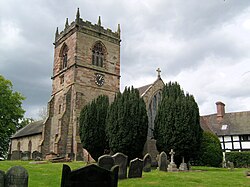Lapley Priory

All Saints Church, Lapley. Much of the building goes back to the 12th century, around the time the priory was established. The priory stood on the site of the timber-framed manor house, behind the church.
|
|
| Monastery information | |
|---|---|
| Order | Benedictine |
| Established | Land donated circa 1061. Monks present before 1086. Date of priory unknown, but by mid-12th century. |
| Disestablished | 1415 |
| Mother house | Abbey of Saint-Remi, Reims, Northern France. |
| Dedicated to | St Peter |
| Diocese | Diocese of Coventry and Lichfield |
| Controlled churches | All Saints Church, Lapley |
| People | |
| Founder(s) | Land donated by Ælfgar, Earl of Mercia |
| Site | |
| Location | Lapley, Staffordshire, United Kingdom |
| Coordinates | 52°42′50″N 2°11′24″W / 52.714°N 2.190°WCoordinates: 52°42′50″N 2°11′24″W / 52.714°N 2.190°W |
|
Listed Building – Grade I
|
|
| Official name | Church of All Saints |
| Designated | 19 March 1962 |
| Reference no. | 1374057 |
|
Listed Building – Grade II
|
|
| Official name | Lapley Manor |
| Designated | 16 May 1953 |
| Reference no. | 1178284 |
Lapley Priory was a priory in Staffordshire, England. Founded at the very end of the Anglo-Saxon period, it was an alien priory, a satellite house of the Benedictine Abbey of Saint-Remi or Saint-Rémy at Reims in Northern France. After great fluctuations in fortune, resulting from changing relations between the rulers of England and France, it was finally dissolved in 1415 and its assets transferred to the collegiate church at Tong, Shropshire.
The origins of the priory lie in grants made in period just before the Norman Conquest. The foundation narrative is told in substantially identical form in several sources and accepted in the Victoria County History account of the priory.
In 1061, Burchard, the son of Ælfgar, Earl of Mercia, accompanied Ealdred, Archbishop of York, on a diplomatic mission overseas. Presumably, this was on Ealdred's journey of that year to get his appointment to the archbishopric confirmed by the Pope, although he still held the see of Worcester in Mercia. The Shropshire historian Robert William Eyton also alleges the visit was at least partly intended to substitute for one promised by the king, Edward the Confessor, himself. They stayed at the great cathedral city and monastic centre of Reims, named after St Remigius, apostle of the Franks, who is buried there in a large Romanesque Basilica. Burchard fell mortally ill and requested burial in the Benedictine Abbey, in return for a donation of land on his behalf. To fulfil his son's desire, and to benefit his soul, Ælfgar gave to St. Rémy five pieces of land: at Lapley, Hamstall Ridware, Meaford, and Marston in Church Eaton, all in Staffordshire, and at Silvington in Shropshire. Eyton pointed out that there were doubts about precisely when Earl Ælfgar died, with some dating his death as early as 1059, but that later scholarship has tended towards 1063, which is consistent with Lapley's foundation story.
...
Wikipedia

